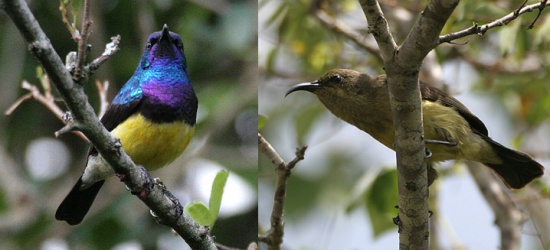Alternative name: Yellow-bellied Sunbird
- Cinnyris venustus
Nectarinia venusta
Identification
10cm
- Thin down-curved bill
- Brush-tipped tubular tongue
Male
- Glossy green head, throat and nape
- Maroon breast band
- Yellow belly
Female
- Grey-brown upperparts
- Yellowish underparts
- Pale supercilium
Eclipse male similar to female but has some green on the throat
Distribution
Africa
Western Africa: Senegambia, Senegal, The Gambia, Guinea-Bissau, Guinea, Mali, Sierra Leone, Liberia, Ivory Coast, Ghana, Togo, Benin, Nigeria, Chad, Cameroon, Central African Republic, Equatorial Guinea, Gabon, DRC, Angola
Eastern Africa: Sudan, Eritrea, Ethiopia, Somalia, Kenya, Uganda, Rwanda, Burundi, Tanzania, Zambia, Mozambique, Malawi
Southern Africa: Namibia, Zimbabwe, South Africa
Taxonomy
This is one of the many Sunbirds that have recently been moved to the genus Cinnyris from the genus Nectarinia.
Subspecies[1]
There are 5 subspecies:
- C. v. venustus:
- C. v. falkensteini:
- C. v. igneiventris:
- C. v. fazoqlensis:
- C. v. albiventris:
Habitat
Dry forest, forest edges, savanna, wood and bushland, suburban gardens and cultivated areas
Behaviour
Breeding
The nest is suspended in a tree. The clutch consists of 2 eggs.
Diet
The diet includes nectar.
Vocalisation
Call: a clear tew-tew-tew-tew-tew.
References
- Clements, JF. 2009. The Clements Checklist of Birds of the World. 6th ed., with updates to December 2009. Ithaca: Cornell Univ. Press. ISBN 978-0801445019.
- Avibase
- Wikipedia
- BF Member observations
Recommended Citation
- BirdForum Opus contributors. (2025) Variable Sunbird. In: BirdForum, the forum for wild birds and birding. Retrieved 29 April 2025 from https://www.birdforum.net/opus/Variable_Sunbird





